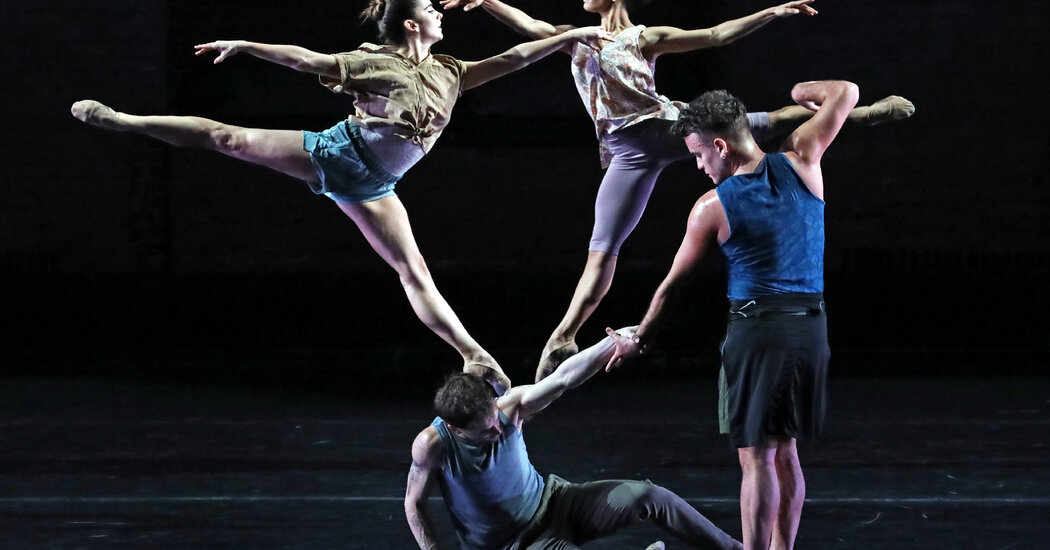Twyla Tharp takes making dances very seriously but, at 82, she appears to be having some fun with it — and even poking fun at herself, lightly, in the process. Her new ensemble work, “The Ballet Master,” which had its premiere on Tuesday at the Joyce Theater, depicts a choreographer immersed in the tortured and revelatory journey of bringing a work to life.
That boisterous ballet closes a program that shows three sides of Tharp, beginning with the punchy “Ocean’s Motion” (1975) and continuing with “Brel,” an introspective new solo for the American Ballet Theater principal Herman Cornejo. (The New York City Ballet principal Daniel Ulbricht performs it on alternate nights.) While “The Ballet Master” concerns itself with the choreographer’s inner world, “Brel” zooms in on the dancer’s.
Before any contemporary self-reflection, though, Tharp takes us back to where she’s been. “Ocean’s Motion,” to a compilation of 1950s and ’60s Chuck Berry songs, feels resolutely of its time and quintessentially Tharp, with its brew of ballet and social dance idioms. Its five fabulous dancers — in short shorts, tight pants and a lot of hot pink — are like a clique of teenagers on the prowl for a good time. They seem less interested in one another (early on, Miriam Gittens sassily brushes Jake Tribus aside) than in the promise of something beyond their closed world, wired with the energy that the music sends surging through their limbs.
With sunny tracks like “Almost Grown” and “School Days” as their motor, feet swivel, shoulders shudder, hips circle and thrust. A time capsule in some respects, the work plants itself in the present thanks to the high-wattage performances of the cast: Daisy Jacobson, Skye Mattox, Reed Tankersley, Gittens and Tribus. The women, especially, volley between a kind of sultry melting and hard-edged snap with uncanny precision.
It must be said plainly in 2024 that the jazz and social dance influence in Tharp’s work is, at its root, a Black American influence. Indebted as she is to Black music and dance lineages, it would be nice to see a more open acknowledgment of these sources — and more than one Black dancer (the phenomenal Gittens) in her current troupe.
“Brel,” to music by Jacques Brel, brings about a tonal shift: away from bubble gum-popping extroversion and into a single dancer’s contemplative space. Tharp has chosen recordings of Brel that include the sound of audience applause, and in this way the solo becomes a performance about performing, alluding to the psychological toll of a life in the spotlight.
Cornejo is known for his stunning athleticism, and while his impeccable leaps and turns are on full display here, the most stirring moments in “Brel” are the quieter ones, and those that acknowledge his relationship to our expectant eyes. Dressed simply in all black, he at one point stands still and scans the audience, his gaze sincere and patient. Later, with one hand at a time, he grasps at something we can’t see, and then releases it toward us. When he breaks out the kinds of steps that win instant adoration — including a finale of coupé jetés circling the stage — they look as effortless as his walking. You feel relieved for him when, as the curtain lowers after his bow, he plops down on the floor with a smile, not masking his exhaustion.
The toil of a life in dance is treated more comically in “The Ballet Master,” which stars the longtime Tharp dancer John Selya as a choreographer trying, haplessly at first, to get his work just right. For the dancers under his direction, that means loops upon loops of repetition, with incremental revisions, beginning with a jocular duet for Tankersley and Tribus. Gittens and Jacobson, arriving as if for rehearsal, leap into the fray as the complexity builds. Tharp captures all this swiftly, aided by the syllabic vocals of Simeon ten Holt’s “Bi-Ba-Bo.”
While Selya appears first as a disheveled guy in jazz shoes and a decorative scarf (the whole program is costumed by Santo Loquasto), he unexpectedly transforms into a (still disheveled) Don Quixote character, and his clipboard-wielding assistant (Ulbricht) into a Sancho Panza sidekick. Inspiration has struck him in the form of a dancer in pointe shoes and layers of pink, a role embodied by the American Ballet Theater principal Cassandra Trenary. Initially just a fleeting presence at the back of the stage, she seems to grow in his imagination. Who’s the real ballet master here?
As the wondrous Trenary works her way into the dance, passing through some mildly creepy artist-muse moments, she also undergoes a transformation: from a ballet dancer to a Tharp dancer, now in gold spandex shorts and matching sneakers, her bourrées replaced with a runner’s strides. (The music has switched to high-drama Vivaldi.) It’s Tharp quoting Tharp. Ulbricht becomes Trenary’s partner, and the original four dancers a corps in perpetual intricate motion. From a whirlwind of exits and entrances, of trying and trying again, passages we’ve seen before — a deliberate fall, a tricky lift — begin to find their groove.
Without fanfare, Selya exits. His vision realized, the dance goes on without him.
Twyla Tharp Dance
Through March 3 at the Joyce Theater, Manhattan; joyce.org.
